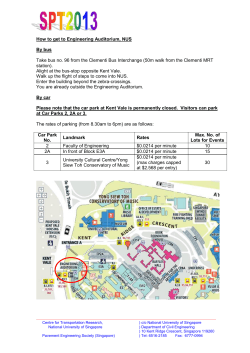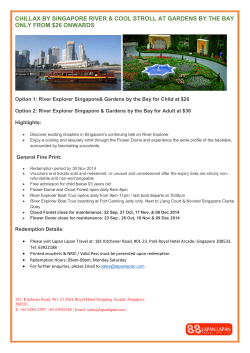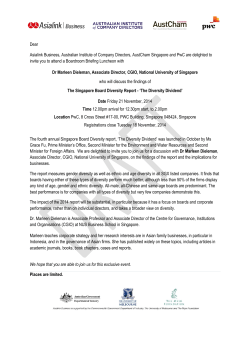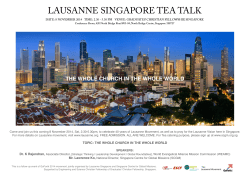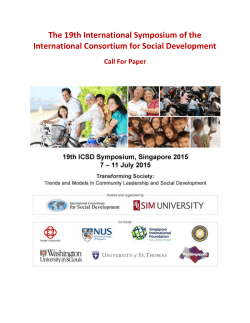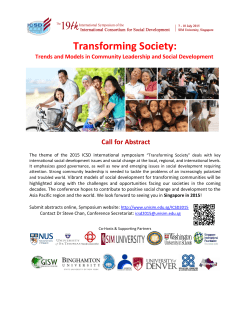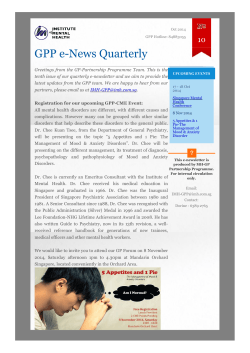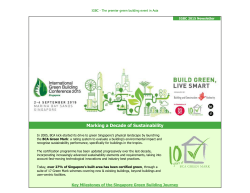
Document
CLIMATE CHANGE AND SINGAPORE Energy Efficiency and Renewable Energy Opportunities for Businesses 20 January 2015 This document was prepared by the National Climate Change Secretariat (NCCS), the Building and Construction Authority (BCA), the Economic Development Board (EDB), the Ministry of the Environment and Water Resources (MEWR), the Ministry of Trade and Industry (MTI), and the National Environment Agency (NEA), to invite public views on addressing climate change and promoting green growth. Energy Efficiency and Renewable Energy Opportunities for Businesses 20 January 2015 Introduction In 2010, the Singapore’s overall fossil fuel (primary oriented economy, overseas markets. industrial sector and buildings sector contributed about 55% and 17% of emissions respectively.1 The emissions are due to direct combustion of emissions) and electricity use (secondary emissions). As an exportmuch of the energy used by our industry is to make products for 2 Singapore’s national energy policy framework seeks to balance economic competitiveness, energy security, and environmental sustainability considerations. In addition to pricing energy right and thereby encouraging conservation through price signals, improving energy efficiency is also one of our key strategies to reduce our energy and carbon footprint. However, energy efficiency measures are sometimes not implemented due to market imperfections such as a lack of information and higher upfront costs. 3 Singapore is already relatively energy and carbon efficient – our carbon emissions per GDP is lower than most countries.2 But there is scope to further enhance energy efficiency through advanced technologies and continued innovation. Energy efficiency also brings about benefits such as cost savings and energy security, in addition to emission reductions. Energy Efficiency Opportunities 4 Industry. Singapore’s manufacturing sector contributes close to 20% of Singapore’s gross domestic product. This sector accounts for more than half of Singapore’s energy demand due to energy-intensive activities such as oil refining, petrochemicals production, and pharmaceutical and semiconductor manufacturing. 5 According to the Intergovernmental Panel on Climate Change (IPCC)’s Fifth Assessment Report (AR5), a scenario with the global application of wide-scale upgrading, replacement and deployment of best-available technology could reduce energy intensity3 from current levels by 25% across the industrial sector. Emerging technologies such as improved waste heat utilisation may further reduce energy intensity by up to 20% before technological limits are reached.4 6 Discussions with companies have identified energy efficiency improvement possibilities for manufacturing such as advanced control systems for automation and process control, better heat recovery/waste heat utilisation, and premium class efficiency motors. However, companies have also highlighted various considerations. For example, retrofitting and equipment upgrades may not be immediately possible due to capital or operational constraints. One suggestion was thus to improve access to capital financing. 1 The buildings sector refers to all non-residential buildings e.g. offices, retail spaces, mixed-use industrial. th Singapore is ranked 113 out of 140 countries, among the best performing 20% globally. Source: 2014 Key World Energy Statistics report by the International Energy Agency (IEA). 3 Energy intensity refers to energy consumed per dollar GDP. 4 Source: IPCC AR5 Working Group III. 2 Page 1 Energy Efficiency and Renewable Energy Opportunities for Businesses 20 January 2015 7 Currently, the Grant for Energy Efficiency Technologies (GREET) aims to encourage businesses to invest in energy efficient equipment or technologies. Companies can apply for funding of up to 20% of the qualifying costs, capped at $4 million per project. In 2014, SDCL5 was appointed to establish a private sector-led pilot financing program for up to S$200 million to fund energy efficiency projects. 8 Other government schemes, such as Design for Efficiency (DfE) and Energy Efficiency Improvement Assistance Scheme (EASe), help companies identify energy efficiency opportunities at the design and operational phase respectively (e.g. through energy audits).6 Various government agencies have also introduced capability building schemes to raise or develop competencies in energy management, such as the Singapore Certified Energy Manager (SCEM) programme, the Energy Services Companies (ESCOs) Accreditation scheme, and the Energy Efficiency National Partnership (EENP)7. 9 The Energy Conservation Act (ECA), which came into force in 2012, will also help identify areas of improvement and enhance understanding of energy performance across different industries and companies over time. Under the ECA, energy-intensive users in the industrial and transport sectors are required to appoint at least one energy manager, report energy use and emissions, and submit energy efficiency improvement plans annually. 10 In July 2014, SPRING announced that $17 million had been set aside to help some 300 SMEs achieve at least 10% energy savings over three years. These savings will be achieved through audits, energy monitoring systems, energy efficiency project implementation, and capability development. Management-level and technical training courses provided by the Sustainable Energy Association of Singapore also support SMEs with the knowledge and tools to finance and deploy energy efficiency technologies. 11 In addition to energy efficiency, enhancing carbon efficiency of the industrial sector is also important in managing emissions. Possible measures to achieve this include switching to using cleaner fuels for energy demand (e.g. using natural gas for boilers instead of fuel oil), and reducing non-CO28 greenhouse gas (GHG) emissions from industrial processes. Some of these measures may incur costs for businesses, and the impacts will need to be studied and considered. 12 Buildings. The buildings sector accounted for about 37% of Singapore’s total electricity demand in 20139. Studies have found that using more efficient technologies, good design practices, and behavioural changes could translate into large energy savings in 5 Sustainable Development Capital LLP (SDCL) is a financial and investment advisory firm. It finances environmental and social infrastructure assets and services. 6 Information on government incentives and schemes for energy efficiency can be found at: http://www.e2singapore.gov.sg/ 7 The EENP organises regular workshops and conferences to facilitate learning and sharing of EE solutions and best practices, and also gives out awards annually to recognise companies with good energy management systems, good EE projects and outstanding energy managers. 8 Non-CO2 emissions from the industrial processes accounted for about 2.4% of Singapore’s total emissions in 2010. Source: Singapore’s First Biennial Update Report 9 Source: Singapore Energy Statistics (SES) 2014 Page 2 Energy Efficiency and Renewable Energy Opportunities for Businesses 20 January 2015 buildings. These efficiency measures typically achieve pay back well within the building’s lifetime.10 Specific opportunities to reduce energy use include improved building design practices, more efficient cooling, lighting technologies and appliances, and the adoption of small-scale renewables.11 The Buildings Energy Efficiency Roadmap, jointly developed by BCA and Nanyang Technological University (NTU), found potential energy efficiency improvements in Singapore due to new technology adoption of up to 40-60% in 2030 compared to ‘best-in-class’ buildings in 2013. 13 Discussions with building owners and relevant stakeholders have identified energy efficiency opportunities in Singapore such as installing or retrofitting building management and information systems (BMIS), high-efficiency air-conditioning & mechanical ventilation (ACMV) systems, and improving thermal performance so that less energy is used for cooling. There are also opportunities to reduce emissions from buildings through deploying renewable energy on buildings. Some challenges to greater energy efficiency in buildings include not fully utilising installed systems for energy management, and split incentives12 between building owners and tenants. 14 Singapore introduced the Green Mark (GM) scheme to promote environmentallyfriendly and energy efficiency buildings in January 2005. Since then, the number of green buildings in Singapore has grown from 17 in the first year, to about 220013 in September 2014. This is shown in Fig 1. 10 Source: IPCC AR5 Working Group III Source: New Climate Economy Report 2014 12 Different objectives as those responsible for paying energy bills (the tenant) may not be the same entity as those making the capital investment decisions (the landlord or building owner) 13 This translates to about 63 million square meters of gross floor area, or 26% of total built-up area in Singapore. 11 Page 3 Energy Efficiency and Renewable Energy Opportunities for Businesses 20 January 2015 Figure 1: Green Mark Building Projects in Singapore (Cumulative) Number of building projects 2500 58.4 45.6 2000 36.1 1500 22.9 1000 500 0 15.3 1.1 17 2.1 33 5.7 10.0 127 GFA 63.3 (million m2) 2195 2002 1556 1170 732 427 239 60.0 50.0 40.0 30.0 20.0 10.0 0.0 FY05 FY06 FY07 FY08 FY09 FY10 FY11 FY12 FY13 FY14 (Sep 2014) 15 To accelerate the pace towards meeting the national target of ‘greening’ 80% of all buildings by 2030, BCA has rolled out a comprehensive suite of initiatives and policies, including the Green Mark Incentive Scheme (GMIS) for both new and existing Buildings, the Green Mark Gross Floor Area (GM GFA) incentive scheme, and the Green Mark Incentive Scheme for Existing Buildings and Premises (GMIS-EBP)14.15 The pilot Building Retrofit Energy Efficiency Financing (BREEF) scheme was also introduced by BCA in 2011 to facilitate financing16 for energy efficiency projects. 16 Since 2008, new buildings and existing buildings undergoing major retrofits have been required by regulation to achieve minimum GM standards.17 In September 2014, the inaugural Building Energy Benchmarking Report (BEBR) was published to spur stakeholders at all levels to initiate and implement improvements in building energy efficiency. The BEBR 14 The $50 million GMIS-EBP was launched in September 2014, and is the first targeted initiative to engage small and medium enterprises (SMEs) to improve energy efficiency standards of their buildings and premises. This enables tenants and occupants to play a bigger role in Singapore’s green building movement. 15 More information on the Green Mark Incentive Schemes can be found at: http://www.bca.gov.sg/Professionals/Technology/technology.html 16 This financing is provided by participating financial institutions (PFIs). More information is available here: http://www.bca.gov.sg/GreenMark/breef.html 17 These legislative requirements were expanded in 2012, mandating annual submission of building energy consumption data for existing building owners, and achieving the minimum Green Mark (GM) standard whenever building cooling systems were installed or replaced. To ensure that the building cooling systems continue to operate efficiently, new and existing building owners are also required to carry out three-yearly energy audits upon notice from the Commissioner of Building Control. Page 4 Energy Efficiency and Renewable Energy Opportunities for Businesses 20 January 2015 found that energy efficiency of buildings, measured by the Energy Utilisation Index (EUI), improved by 5% between 2008 and 2013. This is shown in Fig 2. Figure 2: Energy Utilisation Index Trend of Commercial Buildings 17 In addition, the government is playing an active role in greening public sector buildings through the Public Sector Taking the Lead in Environmental Sustainability (PSTLES)18 initiative. The PSTLES initiative, the suite of GM incentives provided, and the requirement for Government Land Sales (GLS) in strategic growth areas to meet higher prescribed Green Mark standards, are some of the key initiatives available to push the boundaries of building performance beyond code requirements. 18 Within the buildings sector, data centres are significant consumers of energy19. As Singapore’s data centre industry is expected to grow, it is important for data centres to be energy efficient and sustainable. To achieve this, the BCA-IDA Green Mark for Data Centres and the Green Data Centre Standard (SS564) were introduced. The Green Data Centres technology roadmap, commissioned by IDA in 2014, identified several important measures that will improve the energy sustainability of data centres in the future, such as reducing energy required for cooling and improving energy management. 19 To promote greater innovation and development of green building and green data centre solutions, the Government has committed $98 million to funding the Green Buildings Innovation Cluster (GBIC) and the Green Data Centre Programme. The GBIC will provide a 18 2 Under the PSTLES initiative, all new public sector buildings (with more than 5,000 m of air conditioned area) 2 will obtain the GM Platinum rating while all existing public sector buildings (with more than 10,000 m of air PLUS conditioned area) will achieve at least GM Gold rating by 2020. 19 In 2010, the total electrical energy usage of DCs was about 3.6% of Singapore’s total electricity consumption. Electricity accounts for more than 50% of operating expenditure of a typical DC in Singapore. The Infocomm Development Authority (IDA) estimates that a typical large data centre (DC) in Singapore consumes energy equivalent to 10,000 households. Source: NEA DC Energy Efficiency Benchmarking Report 2012 Page 5 Energy Efficiency and Renewable Energy Opportunities for Businesses 20 January 2015 platform to demonstrate promising building solutions and build capabilities in energy efficiency. In addition, the Economic Development Board (EDB) has launched the PreProject Innovation Consortium initiative, which brings players from different parts of the building industry ecosystem together during the design and planning stage for integrated design and development of innovative green buildings solutions. Renewable Energy Opportunities 20 Solar energy is currently the most economically and technically viable clean energy source for Singapore. The government aims to raise the adoption of solar power in our system to 350 Mega-Watt-peak (MWp) by 2020. This is about 5 per cent of 2020 peak electricity demand, a significant increase from the 24 MWp of installed capacity in late 2014. The emergence of solar leasing and other services in the private sector will further facilitate the deployment of solar PV. For example, there is an online platform which functions as a solar exchange marketplace to help potential buyers of solar PV systems estimate expected installation costs and energy savings. In addition, information on solar PV systems, meteorological information, and solar industry contacts can be found at the National Solar Repository of Singapore. 21 Various companies and institutions across Singapore have installed solar PV systems. One example is Keppel Seghers, which set up a 1 MWp PV system on a waste water treatment plant to supply solar energy for water treatment. Another example is the Singapore American School, which installed a 1MWp system that meets about 10%20 of the school’s energy needs. Figure 3: The Singapore American School’s 1 MWp Solar PV System Source: Sunseap Leasing 20 Source: The Straits Times Page 6 Energy Efficiency and Renewable Energy Opportunities for Businesses 20 January 2015 Questions Energy Efficiency What are the a) opportunities and benefits, b) challenges for your business/ your company if there is greater national emphasis or support for energy efficiency? What would it take for businesses/ buildings to accelerate development or deployment of energy efficiency solutions? What are the key considerations? Do you/ your business/ your company have the information to make better energy management decisions? What needs to be done to get the information and how can this information be made more accessible? Will minimum energy efficiency standards for generic equipment such as motors, cooling systems and compressor systems help facilitate your energy efficiency initiatives? Why or why not? [For financiers] What are the key issues/risks financial institutions face in providing loans/financing for energy efficiency projects, and how can these issues be addressed? [For SMEs] Are there any specific barriers to energy efficiency for small and medium enterprises? Renewable Energy What are some key considerations that influence whether you/ your business/ your company will harness solar PV in Singapore? What would help accelerate take-up of clean energy in the industry and building sectors? [For financiers] What are the key issues/risks financial institutions face in providing loans/financing for the purchase of solar PV panels? How can these issues be addressed? Other Feedback Please share any other comments on increasing energy efficiency or raising renewable energy deployment in the industry or buildings sector in Singapore. Page 7
© Copyright 2025


